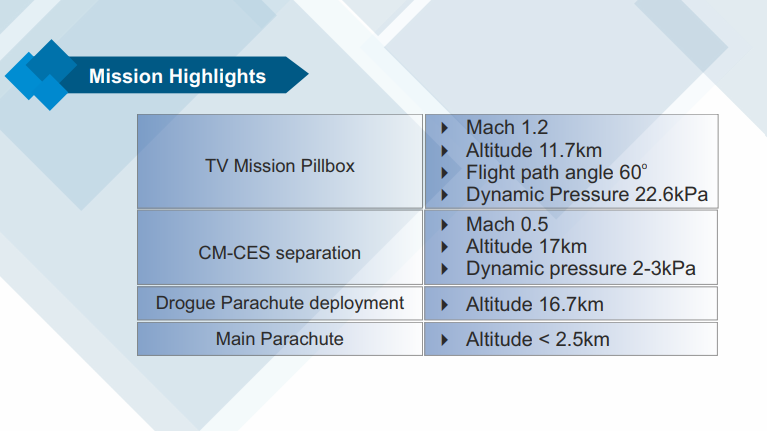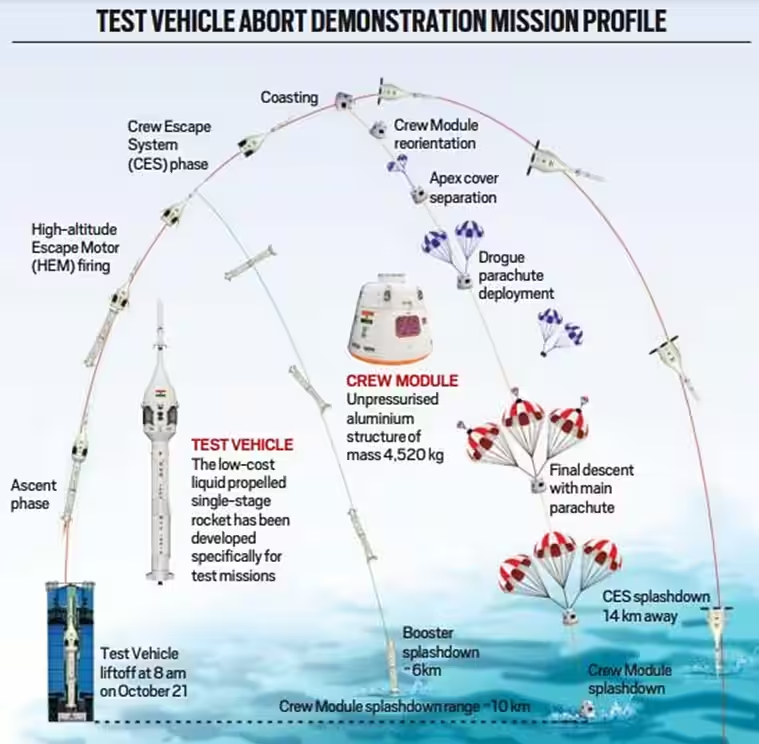Science & Technology
Test on Crew Escape System
- 24 Oct 2023
- 8 min read
For Prelims: Indian Space Research Organisation (ISRO), Crew Escape System, Human Space Flight Mission, Flight Test Vehicle Abort Mission-1 (TV-D1), LVM3 Rocket, GSLV Mk III Rocket, Crew module Atmospheric Re-Entry Experiment (CARE), International Space Station (ISS).
For Mains: Impact of the recent tests of Crew Escape System on India's Gaganyaan Mission, Achievements of Indians in Science and Technology.
Why in News?
Recently, Indian Space Research Organisation (ISRO) carried out the first of a series of tests of systems and procedures called the Flight Test Vehicle Abort Mission-1 (TV-D1) with the aim to ultimately fulfill the objectives of Gaganyaan Mission perhaps by 2025.
What is the TV-D1 Test?
- About:
- The Flight Test Vehicle Abort Mission-1 (TV-D1) demonstrates the performance of the Crew Escape System of the Gaganyaan project.
- The flight is the first of two abort missions to test the safety mechanisms that will allow the Gaganyaan crew to leave the spacecraft in an emergency.
- The Test Vehicle is a single-stage liquid rocket developed for this abort mission. The payloads consist of the Crew Module (CM) and Crew Escape Systems (CES) with their fast-acting solid motors, along with CM fairing (CMF) and Interface Adapters.
- Mechanism:
- The test exercise will see the rocket rise to an altitude of almost 17 km before an abort signal is triggered, leading to the separation of the crew module, which will descend using a parachute for a splashdown in the Bay of Bengal.
- The rocket, ISRO’s new, low-cost Test Vehicle, will reach a peak relative velocity of 363 metres/ second (about 1307 km/ hr) during the flight and the crew module will be empty for the test.
- Relevance:
- It will demonstrate a basic version of the crew module — the capsule in which the astronauts will be seated during the Gaganyaan human space flight.
- The test will check the functioning of systems for separating the crew module from the rocket in case of a mid-flight emergency (abort mission) and the escape of astronauts.
What is the New Test Vehicle To Be Used in TV-D1?
- Introduction to the New Test Vehicle:
- The ISRO plans to conduct a full-fledged crew module test flight in 2024 using the human-rated LVM3 rocket. However, for the TV-D1 mission, ISRO has developed a low-cost test vehicle specifically designed to evaluate various systems.
- Features of the Test Vehicle:
- The Test Vehicle incorporates existing liquid propulsion technology.
- Notable innovations include the throttleable and restartable L110 Vikas engine, a core component of the LVM3 rocket's second stage, which offers better control over propellant usage.
- The Test Vehicle incorporates existing liquid propulsion technology.
- Cost-Effective Alternative to GSLV Mk III:
- Previous crew module test flights, like the Crew module Atmospheric Re-Entry Experiment (CARE) in 2014, utilized expensive GSLV Mk III rockets, costing Rs 300-400 crore each. In response to cost concerns, ISRO has introduced the more economical Test Vehicle.
- Utilization of the Test Vehicle for Various Space Technologies:
- The Test Vehicle will serve as a platform for testing and developing multiple space technologies, including Scramjet engine technology for reusable space launch vehicles.
- ISRO recognizes the significance of testing the Crew Escape System of the Gaganyaan mission multiple times without incurring substantial expenses, making the Test Vehicle a valuable asset for future space endeavors.
What is the Present Crew Escape System (CES) in Gaganyaan Mission?
- Lessons From Failure of Russian Soyuz Rocket :
- In 2018, a Soyuz FG rocket failure prompted an emergency crew escape during Expedition 57 to the International Space Station( ISS) . At 50 km altitude, the crew module separated from the rocket, ensuring the safe return of astronauts. This marked the first mid-flight Soyuz rocket failure since 1975 and the initial failure of the Soyuz FG in 55 launches.
- Ensuring Crew Safety in Gaganyaan:
- ISRO prioritizes crew safety in the Gaganyaan project and seeks to extend the 2022 deadline for a secure mission. The crew module must withstand high heat and pressure conditions and feature a reliable escape system in emergencies.
- ISRO is developing life support systems and an integrated health management system to detect anomalies endangering astronauts and initiate mission aborts.
- TV-D1 Mission Stages:
- In the TV-D1 flight, the Crew Escape System separates from the Test Vehicle around 11.7 km altitude. After approximately 90 seconds, the crew module detaches, deploys parachutes, and descends slowly over seven minutes.
- The Indian Navy will recover the crew module from the Bay of Bengal, marking a crucial milestone in the Gaganyaan program's development.
- Gaganyaan Mission Status:
- The Gaganyaan mission's timeframe is currently 2024 or later, emphasizing safety over haste. An unmanned mission is planned for the beginning of the following year, with abort missions in the same year.
- The manned mission is expected by late 2024 or early 2025, depending on various scenarios.
- ISRO has already achieved human rating for critical rocket components, and Crew Escape System design is obliged to ensure the safeguard mechanism for astronauts over deadline.
UPSC Civil Services Examination Previous Year Question (PYQ)
Prelims
Q. With reference to India’s satellite launch vehicles, consider the following statements: (2018)
- PSLVs launch the satellites useful for Earth resources monitoring whereas GSLVs are designed mainly to launch communication satellites.
- Satellites launched by PSLV appear to remain permanently fixed in the same position in the sky, as viewed from a particular location on Earth.
- GSLV Mk III is a four-staged launch vehicle with the first and third stages using solid rocket motors; and the second and fourth stages using liquid rocket engines.
Which of the statements given above is/are correct?
(a) 1 only
(b) 2 and 3
(c) 1 and 2
(d) 3 only
Ans: (a)
Mains
Q. What is India’s plan to have its own space station and how will it benefit our space programme? (2019)








